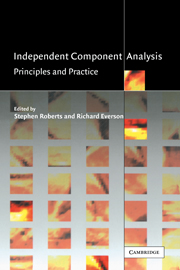Book contents
- Frontmatter
- Contents
- Preface
- Contributors
- 1 Introduction
- 2 Fast ICA by a fixed-point algorithm that maximizes non-Gaussianity
- 3 ICA, graphical models and variational methods
- 4 Nonlinear ICA
- 5 Separation of non-stationary natural signals
- 6 Separation of non-stationary sources: algorithms and performance
- 7 Blind source separation by sparse decomposition in a signal dictionary
- 8 Ensemble Learning for blind source separation
- 9 Image processing methods using ICA mixture models
- 10 Latent class and trait models for data classification and visualisation
- 11 Particle filters for non-stationary ICA
- 12 ICA: model order selection and dynamic source models
- References
- Index
4 - Nonlinear ICA
Published online by Cambridge University Press: 05 July 2014
- Frontmatter
- Contents
- Preface
- Contributors
- 1 Introduction
- 2 Fast ICA by a fixed-point algorithm that maximizes non-Gaussianity
- 3 ICA, graphical models and variational methods
- 4 Nonlinear ICA
- 5 Separation of non-stationary natural signals
- 6 Separation of non-stationary sources: algorithms and performance
- 7 Blind source separation by sparse decomposition in a signal dictionary
- 8 Ensemble Learning for blind source separation
- 9 Image processing methods using ICA mixture models
- 10 Latent class and trait models for data classification and visualisation
- 11 Particle filters for non-stationary ICA
- 12 ICA: model order selection and dynamic source models
- References
- Index
Summary
This chapter deals with independent component analysis and blind source separation for nonlinear data models. A fundamental difficulty, especially in the nonlinear ICA problem, is that it is highly non-unique without a suitable regularization. After considering this, two methods for solving the nonlinear ICA and BSS problems are presented in more detail. The first one is a maximum likelihood method based on a modified generative topographic mapping. The second approach applies Bayesian ensemble learning to a flexible multi-layer perceptron model for finding the sources and nonlinear mixing mapping that have most probably given rise to the observed mixed data. Finally, other techniques introduced for the nonlinear ICA and BSS problems are briefly reviewed.
Introduction
Independent Component Analysis [Lee, 1998, Oja et al., 1997, Girolami, 1999bl is a statistical technique which tries to represent the observed data in terms of statistically independent component variables. ICA is closely related to the blind source separation (BSS) problem [Cardoso, 1998a, Amari et al., 1996, Lee, 1998, Oja et al., 1997, Girolami, 1999b1, where the general goal is to separate mutually independent but otherwise unknown source signals from their observed mixtures without knowing the mixing process.
- Type
- Chapter
- Information
- Independent Component AnalysisPrinciples and Practice, pp. 113 - 134Publisher: Cambridge University PressPrint publication year: 2001
- 6
- Cited by

